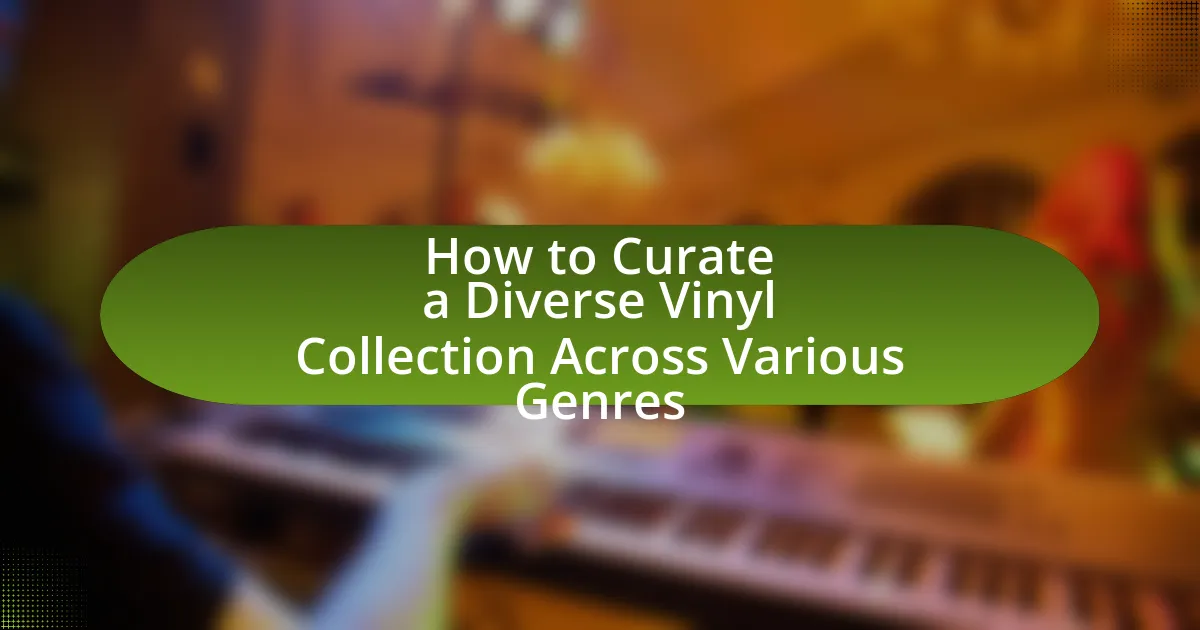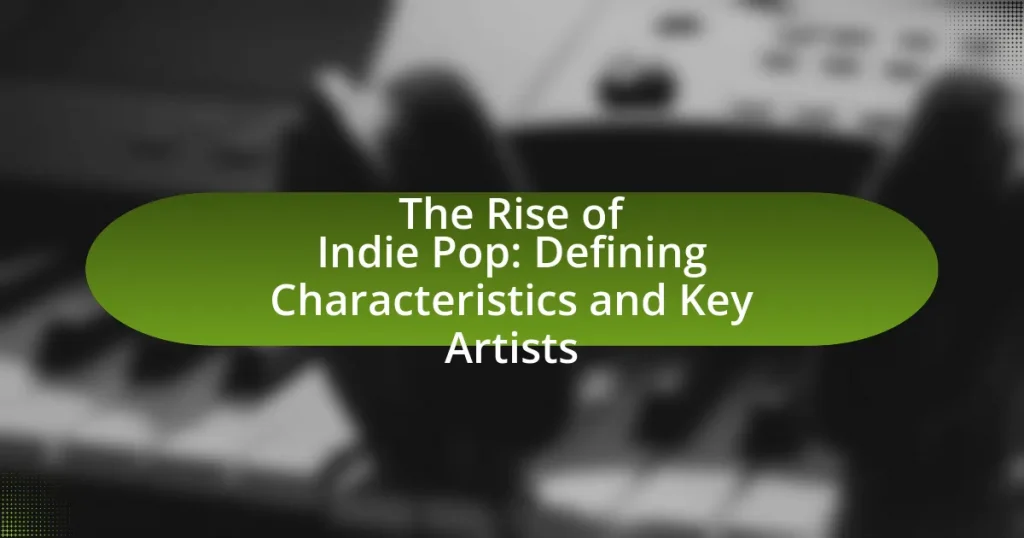Curating a diverse vinyl collection across various genres involves the intentional selection of records that represent a wide array of musical styles and cultural backgrounds, including rock, jazz, hip-hop, classical, and world music. This practice enhances the listening experience by exposing collectors to different musical traditions and historical contexts, fostering greater cultural understanding and appreciation. The article outlines the importance of diversity in vinyl collections, key genres to consider, methods for identifying personal taste, and strategies for sourcing authentic records. Additionally, it discusses best practices for maintaining and expanding a diverse collection, emphasizing the cognitive and emotional benefits of engaging with varied musical genres.

What does it mean to curate a diverse vinyl collection across various genres?
Curating a diverse vinyl collection across various genres means intentionally selecting records that represent a wide range of musical styles and cultural backgrounds. This practice enriches the collection by including genres such as rock, jazz, hip-hop, classical, and world music, allowing for a broader appreciation of music’s diversity. Research indicates that exposure to varied musical genres can enhance creativity and cultural understanding, as noted in studies by the Journal of Music Therapy, which highlight the cognitive benefits of diverse musical experiences.
Why is diversity important in a vinyl collection?
Diversity is important in a vinyl collection because it enhances the listening experience by exposing collectors to a wide range of musical styles, cultures, and historical contexts. A varied collection allows for exploration of different genres, such as jazz, rock, classical, and world music, which can deepen appreciation for the art form and foster a broader understanding of music’s evolution. Furthermore, studies show that diverse musical exposure can improve cognitive flexibility and creativity, as engaging with various sounds and rhythms stimulates different areas of the brain. This multifaceted approach to collecting not only enriches personal enjoyment but also promotes cultural awareness and appreciation.
How does genre diversity enhance the listening experience?
Genre diversity enhances the listening experience by providing a broader range of emotional and auditory stimuli, which keeps listeners engaged and allows for exploration of different cultural expressions. Exposure to various genres, such as jazz, classical, rock, and hip-hop, introduces unique rhythms, melodies, and lyrical themes that can evoke different feelings and thoughts. Research indicates that diverse musical experiences can improve cognitive flexibility and emotional intelligence, as listeners learn to appreciate contrasting styles and contexts. This variety not only enriches personal taste but also fosters a deeper understanding of music as a universal language, ultimately leading to a more fulfilling auditory journey.
What cultural perspectives can be gained from a diverse collection?
A diverse collection provides insights into various cultural perspectives by showcasing the unique musical traditions, social contexts, and historical narratives of different communities. For instance, a vinyl collection that includes genres like jazz, reggae, and traditional folk music reflects the cultural heritage and social issues of African American, Caribbean, and indigenous populations, respectively. This variety allows listeners to understand the influences of geography, history, and social movements on music, thereby fostering empathy and appreciation for different cultures. Research indicates that exposure to diverse cultural expressions can enhance cross-cultural understanding and reduce prejudice, as highlighted in studies by the American Psychological Association.
What are the key genres to consider when curating a vinyl collection?
The key genres to consider when curating a vinyl collection include rock, jazz, classical, hip-hop, electronic, and country. Rock is foundational to vinyl culture, with iconic albums from artists like The Beatles and Led Zeppelin. Jazz offers rich improvisational styles, featuring legends such as Miles Davis and John Coltrane. Classical music provides timeless compositions from composers like Beethoven and Mozart, appealing to a wide audience. Hip-hop has revolutionized music since the 1970s, with influential records from artists like Run-D.M.C. and Nas. Electronic music showcases diverse subgenres, from house to techno, with pivotal albums by Kraftwerk and Daft Punk. Lastly, country music, with its storytelling tradition, includes essential works from artists like Johnny Cash and Dolly Parton. Collecting across these genres ensures a well-rounded and culturally significant vinyl collection.
How do different genres influence the overall collection?
Different genres significantly influence the overall collection by shaping the diversity and appeal of the vinyl selection. Each genre introduces unique characteristics, styles, and cultural contexts that attract different audiences, thereby enhancing the collection’s richness. For instance, incorporating genres like jazz, rock, and hip-hop not only broadens the musical spectrum but also reflects various historical and social movements, as evidenced by the impact of jazz on the civil rights movement and rock’s role in counterculture. This genre diversity can lead to increased engagement and appreciation among collectors, as it allows for exploration of varied musical landscapes and fosters a deeper understanding of the evolution of music.
What are some essential albums from each genre?
Essential albums from various genres include:
- Rock: “The Dark Side of the Moon” by Pink Floyd, released in 1973, is a landmark album known for its innovative production and concept-driven approach.
- Pop: “Thriller” by Michael Jackson, released in 1982, remains the best-selling album of all time, showcasing a blend of pop, rock, and funk.
- Hip-Hop: “Illmatic” by Nas, released in 1994, is critically acclaimed for its lyrical depth and production quality, often cited as one of the greatest hip-hop albums.
- Jazz: “Kind of Blue” by Miles Davis, released in 1959, is celebrated for its modal jazz style and has influenced countless musicians across genres.
- Country: “At Folsom Prison” by Johnny Cash, released in 1968, is a defining live album that captures the essence of Cash’s storytelling and authenticity.
- Electronic: “Selected Ambient Works 85-92” by Aphex Twin, released in 1992, is a seminal work in electronic music, known for its innovative soundscapes.
- Metal: “Master of Puppets” by Metallica, released in 1986, is a cornerstone of heavy metal, recognized for its complex compositions and themes.
These albums are essential due to their significant impact on their respective genres and their lasting influence on music as a whole.
How can one assess personal taste while curating a diverse collection?
To assess personal taste while curating a diverse collection, one should actively engage in listening to a wide range of genres and styles. This process involves exploring different musical eras, artists, and cultural influences to identify preferences and dislikes. By maintaining a listening journal or playlist, individuals can track their reactions to various tracks, which helps in recognizing patterns in their musical inclinations. Research indicates that exposure to diverse music can enhance appreciation and understanding of different genres, thereby refining personal taste. For instance, a study published in the Journal of Music Theory found that listeners who engage with a variety of musical styles develop a more nuanced understanding of music, which aids in curating a collection that reflects their evolving tastes.
What methods can help identify preferred genres and artists?
To identify preferred genres and artists, one effective method is to analyze listening habits through music streaming platforms, which often provide personalized recommendations based on user behavior. These platforms utilize algorithms that track user interactions, such as song skips, likes, and playlists, to suggest genres and artists that align with individual preferences. For instance, Spotify’s Discover Weekly feature curates a playlist tailored to a user’s listening history, showcasing artists and genres that the user is likely to enjoy. Additionally, engaging in music surveys or quizzes can help pinpoint specific tastes, as they often ask users about their favorite songs, artists, and genres, leading to more refined recommendations.
How can exploring new genres expand personal taste?
Exploring new genres can significantly expand personal taste by introducing individuals to diverse musical styles and cultural influences. When a person listens to various genres, they encounter different rhythms, melodies, and lyrical themes that challenge their existing preferences. This exposure can lead to a broader appreciation for music, as studies show that familiarity with a wider range of genres enhances overall enjoyment and understanding of music (Hargreaves & North, 1999). By actively seeking out and engaging with new genres, individuals can discover unexpected favorites, thereby enriching their musical landscape and personal identity.
What strategies can be employed to find diverse vinyl records?
To find diverse vinyl records, one effective strategy is to explore various music genres and cultures through dedicated record stores, online marketplaces, and music festivals. Visiting local record shops that specialize in different genres can expose collectors to unique selections that may not be available elsewhere. Online platforms like Discogs and eBay offer extensive catalogs where users can filter searches by genre, region, and rarity, facilitating the discovery of diverse records. Additionally, attending music festivals and events often provides opportunities to purchase vinyl directly from artists and independent labels, further enhancing the diversity of a collection. Engaging with online communities and forums focused on vinyl collecting can also yield recommendations and insights into lesser-known artists and genres, enriching the overall collection.
How can local record stores contribute to a diverse collection?
Local record stores can contribute to a diverse collection by actively sourcing and stocking a wide range of genres, including niche and underrepresented music styles. These stores often collaborate with local artists and labels, providing a platform for diverse voices and sounds that may not be available in mainstream outlets. For instance, a study by the Music Industry Research Association found that independent record stores are crucial in promoting local music scenes, which enhances the variety of music accessible to consumers. Additionally, local record stores frequently host events, such as listening parties and live performances, that celebrate different musical traditions, further enriching their collections and fostering community engagement.
What role do online platforms play in discovering new genres?
Online platforms play a crucial role in discovering new genres by providing access to a vast array of music and facilitating user-generated recommendations. These platforms, such as Spotify and YouTube, utilize algorithms that analyze listening habits to suggest unfamiliar genres and artists, thereby broadening users’ musical horizons. For instance, Spotify’s Discover Weekly feature curates personalized playlists that introduce listeners to new genres based on their previous choices, leading to increased exposure and exploration of diverse musical styles. This data-driven approach not only enhances user experience but also supports emerging artists by connecting them with audiences who may not have encountered their work otherwise.
How can collectors ensure they are purchasing authentic vinyl records?
Collectors can ensure they are purchasing authentic vinyl records by verifying the provenance and condition of the records. Authenticity can be confirmed through examining the record label, matrix numbers, and any accompanying documentation, such as original inserts or receipts. For instance, reputable sellers often provide detailed descriptions and photographs that showcase these elements, allowing collectors to cross-reference with known authentic examples. Additionally, utilizing resources like Discogs or Record Collector magazine can help collectors identify legitimate pressings and avoid counterfeits.
What are the signs of counterfeit vinyl records?
Signs of counterfeit vinyl records include poor quality printing on the cover, incorrect label designs, and substandard audio quality. Authentic records typically feature high-resolution artwork and precise label details, while counterfeits often have blurry images or misspellings. Additionally, counterfeit records may lack the proper weight and feel, as genuine vinyl is usually heavier and more durable. The presence of a barcode or catalog number that does not match known releases can also indicate a counterfeit. Collectors should verify these details against reputable sources to ensure authenticity.
How can one verify the authenticity of a record before purchase?
To verify the authenticity of a record before purchase, one should examine the record’s label, matrix numbers, and packaging details. Authentic records typically feature specific label designs and matrix numbers that correspond to known pressings, which can be cross-referenced with reputable discography databases such as Discogs. Additionally, inspecting the condition of the vinyl and the presence of any unique identifiers, such as a barcode or catalog number, can further confirm authenticity. Collectors often rely on these details to distinguish between original pressings and counterfeit versions, ensuring the integrity of their vinyl collection.
What are the best practices for maintaining a diverse vinyl collection?
To maintain a diverse vinyl collection, collectors should regularly explore various genres, artists, and eras to ensure a broad representation of music. This practice encourages the inclusion of different styles, such as jazz, rock, classical, hip-hop, and world music, which enriches the collection’s diversity. Additionally, attending record fairs, visiting local record stores, and engaging with online vinyl communities can expose collectors to lesser-known artists and genres, further enhancing variety. Research indicates that a diverse collection not only reflects personal taste but also fosters a deeper appreciation for music’s cultural significance, as seen in studies highlighting the benefits of musical diversity on cognitive and emotional development.
How should vinyl records be stored to preserve quality?
Vinyl records should be stored vertically to preserve quality, as this prevents warping and damage. Storing records upright minimizes pressure on the grooves, which can lead to sound degradation over time. Additionally, maintaining a stable environment with low humidity and a consistent temperature between 65°F and 70°F helps protect the vinyl from environmental factors that can cause deterioration. Using protective sleeves made of anti-static material further safeguards the records from dust and scratches, ensuring longevity and optimal sound quality.
What cleaning techniques are recommended for vinyl records?
To clean vinyl records effectively, it is recommended to use a combination of dry and wet cleaning techniques. Dry cleaning involves using a carbon fiber brush to remove dust and debris from the record’s surface, which helps prevent scratches during playback. Wet cleaning techniques include using a specialized vinyl record cleaning solution applied with a microfiber cloth or a record cleaning machine, which can remove deeper dirt and grime. Research indicates that using a cleaning solution specifically designed for vinyl can enhance sound quality and prolong the lifespan of the records.
What tips can help in curating a diverse vinyl collection effectively?
To effectively curate a diverse vinyl collection, focus on exploring various genres, artists, and eras. Start by identifying key genres such as rock, jazz, hip-hop, classical, and electronic, and seek out influential albums within each category. For instance, including landmark albums like Miles Davis’ “Kind of Blue” in jazz or The Beatles’ “Sgt. Pepper’s Lonely Hearts Club Band” in rock ensures foundational representation. Additionally, attend local record fairs and shops to discover regional artists and lesser-known records, which can enhance the uniqueness of your collection. Engaging with online communities and forums dedicated to vinyl collecting can also provide recommendations and insights into emerging artists and trends, further broadening your collection’s diversity.
How can setting a budget influence the curation process?
Setting a budget significantly influences the curation process by establishing financial limits that guide purchasing decisions. A defined budget helps collectors prioritize which genres or specific records to focus on, ensuring that they allocate funds effectively across a diverse range of vinyl. For instance, if a collector has a budget of $500 for the year, they may decide to spend $200 on jazz, $150 on rock, and $150 on electronic music, thereby promoting a balanced collection. This strategic allocation not only prevents overspending but also encourages collectors to research and select high-quality records within their financial constraints, ultimately enhancing the diversity and value of their collection.
What role does networking with other collectors play in expanding a collection?
Networking with other collectors plays a crucial role in expanding a collection by facilitating access to rare items, sharing knowledge, and fostering trade opportunities. Engaging with fellow collectors allows individuals to discover unique records that may not be available through traditional retail channels. For instance, collectors often exchange information about upcoming sales, auctions, or private collections, which can lead to acquiring sought-after vinyl. Additionally, networking enhances understanding of various genres, as collectors share insights and recommendations, enriching the overall collection experience. This collaborative environment can significantly increase the diversity and quality of a collector’s vinyl collection.



